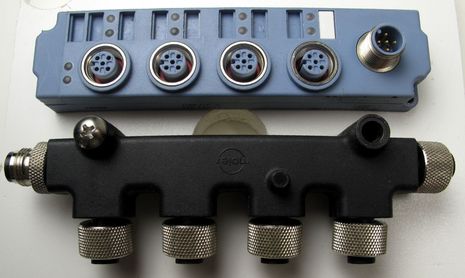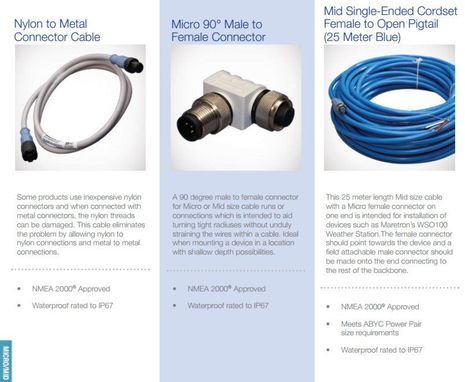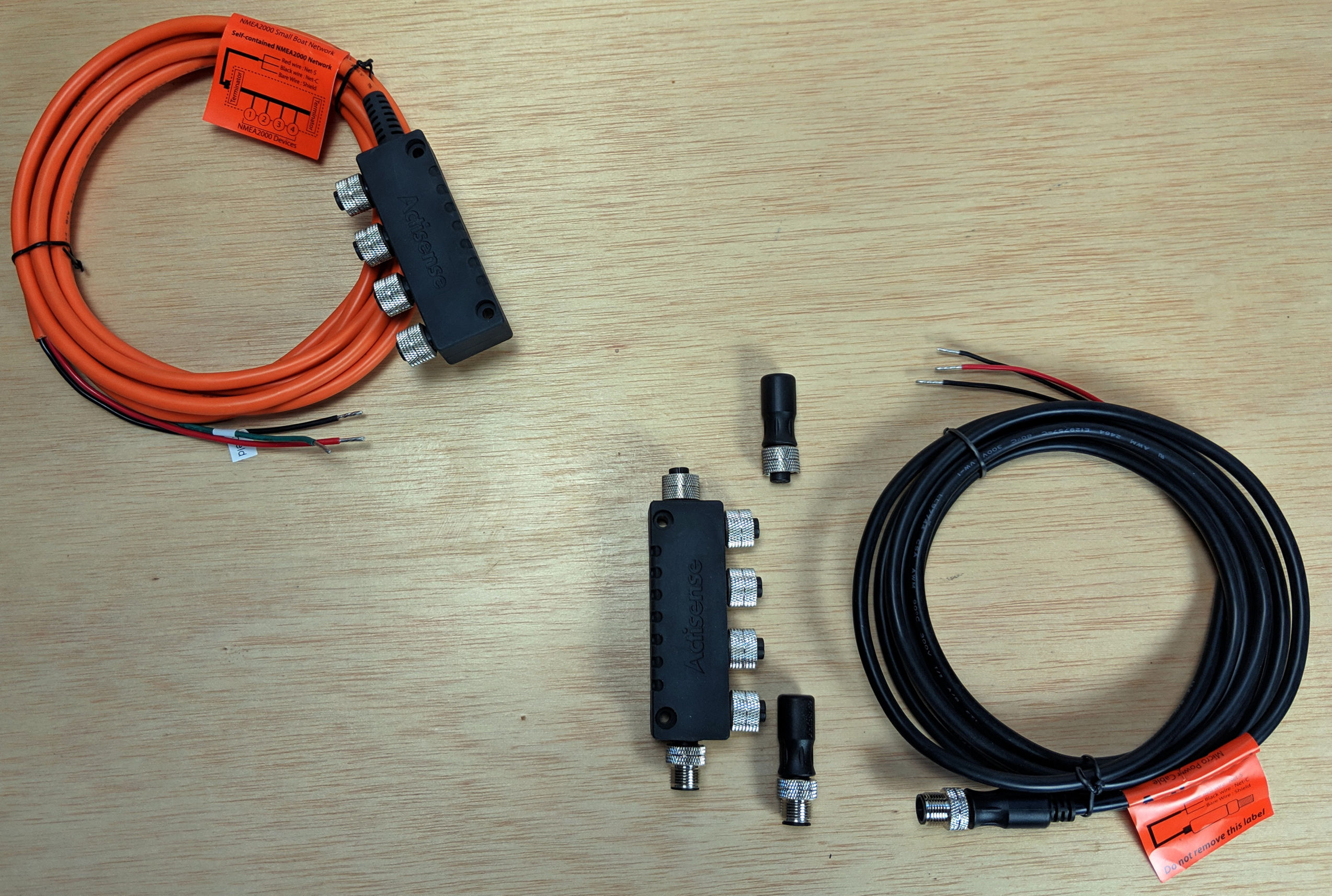Actisense QPD & A2K, more good choices in NMEA 2000 cabling
I believe that the new Actisense QPD-1 seen above is the best NMEA 2000 power drop yet, as long as you can live with its bulk. It’s not just a split power drop — advantages described here — but it has its own blade fuses and LED diagnositc indicators, and it includes diodes that protect the backbone and the power sources from reverse polarity and back feed. It also comes in two models: The QPD-1-PMW above has nickle-plated brass Micro connectors meant to work with pre-made backbone sections while the QPD-1-GLA has glands to facilitate use with bulk N2K cabling. But while it’s great that Actisense’s growing line of cables and connectors are designed to support both install styles, you may still want to mix in parts from other manufacturers…
Actisense, for instance, does not yet offer anything quite like the two N2K connectors below. At top is a Maretron Multiport (made by Escha, I think) and below it is a Molex Brad DeviceNet quadruple Tee. Each enables four drops off an N2K Micro-size backbone (aka DeviceNet), but the multiport is slightly different in that it connects to the trunk via another Tee while the Molex has the trunk running right through it. Some say that a multiport is better in terms of protecting the clean impedance (explained here) that’s critical to keeping a large N2K network happy, but there are plenty of 2000 installs where the multi-tee would work very nicely…
But then again, Actisense has long offered the very versatile QNB-1, and they’ve made it even more so by offering male and female Panel Mount Wired (PWM) connectors that easily interchange with the glands. It’s worth noting that the particular QNB-1 seen below is the one I first tested in 2008 in the little power cat now named Li’l Gizmo, and that it’s endured a lot of salty air inside the center console since, and that I didn’t clean it a bit before installing that A2K-PWM-M, which took about five minutes. A QNB-1 is bulky but you get a fused split power feed, two backbone connections, and six device drops…
I also like Actisense’s new A2K Tee connectors (more on the whole A2K line here). There are reasons behind that blocky design. For one thing they each have two fastener holes and for another they’re high enough that it’s easy to screw or unscrew a cable while the tee remains fastened. I also noticed that they are deeply embossed with the Actisense name, which suggests that they are the first metal N2K connectors specifically made for a marine electronics company…
But then again, I spotted several unusual items in the latest Maretron catalog (download here) that each could improve particular N2K installs. At left (below) is connector cable with a nylon female end for connecting safely — i.e. without cross threading — to the many devices that don’t have metal NMEA 2000 ports. (Remember that most — but, drats, not all — N2K cable/connector systems are designed to go male-to-female from all devices and backbone terminating resistors to the power feed, so that hot male power pins are never exposed.)
At center is a compact right-angle connector that could be a miracle in some tight situations, and at right is a long cord set — for backbone use only, as drops are limited to 6 meters — with a female connector molded on one end and bare wires on the other. It’s also Mid size, which is a unique Maretron product that has larger gauge power wires to minimize voltage drop but still uses Micro connectors rather than the expensive and hard-to-run Mini size…
Now I’d like to see to more choices in female-end only cables, as they seem perfect for an easy and waterproof connection to an N2K device while also enabling tough cable runs to a break-out box like the QNB. In fact, I think it would be genius if some manufacturer offered cables with female connectors on both ends; they could be efficiently chopped in two for the purpose just mentioned, or used to switch genders (which does come up). I’m not keen on field-attachable connectors unless there’s a good reason for them (though I was pleased to note that Maretron now has 90 degree models).
But my point in all this rambling is that there are more and more ways to rig a NMEA 2000 network, and that’s a good thing. And while I’ve come to appreciate the desire of owners and boatyards to minimize the number of vendors involved in an install, I think N2K cabling is an exception as service and warranty issues are minimal. I suppose there are aesthetic considerations but if I ever do a long term N2K install on the big Gizmo — planned last Spring, and the Spring before! — it may well have dark blue Maretron Mid-size trunk cabling and a mix of micro drops and connectors. I think that could look and work fine, and the blue Mid would visually indicate the backbone to whoever cares.
What about the costs? While I have not researched that subject definitively, I remain convinced that the higher-quality metal-using connectors and cables are not much more expensive than the alternative. However, a limited-edition, long-billed, sun-resistant Panbo hat awaits the reader willing to compile an accurate comparative chart of N2K tee and cable street prices. Just let me know if you’re interested so we can avoid duplicate efforts.



















So much blather, and I still didn’t explain the last photo. The tees and terminal resistors left to right: the new Actisense A2K, the Molex that Maretron used to sell, the Escha that Maretron sells now (they like fastening down the cable rather than the tee), the LTW that Furuno sells, and finally the non-metallic gear sold by Garmin and Lowrance.
Ben,
you should compare 3 Tees and 2 terminator block lenght in all of those versions pictured at the end, as a space occupying comparsion for backbone… Also, pin position inside the connector that define angle between tees of different manufacturers should be compared too, to see what possible complications are when combining tee brands
There is one problem when mixing N2K “T” connectors. Each manufacturer locates the keyway at a different point on the connector. This results in the drop cable either sticking out or angled against the bulkhead. It’s amazing how something as simple as this can ruin the look of an otherwise clean install. I guess NMEA never specified where the keyway was to be placed when setting the specifications for the connectors. My solution to this is to just use a multiport box whenever possible.
Also, It is very easy, if you are not extremely careful, to cross thread a metal Maretron connector to the plastic Garmin thread on the back of the chartplotter. Anytime you mix metal threads with plastic it can be a serious problem. If you cross thread you will not have a tight connection or a waterproof one. I wish Garmin would change to all metal threads for N2k on the back of their products. Garmin – Go ahead and charge me the $5 additional and use the improved metal connector as a marketing point.
I suspect the metal retaining ring in a marine environment represent a corrosion opportunity. having a cable connector seized to the body connector on an expensive device would provoke an owner’s ire.
given that the metal in the connectors i’ve looked at are plated, the situation could be exacerbated by dissimilar metals which get in contact when the plating wears on a thread surface.
another advantage of composite connectors is they are both more resistant to some kinds of damage that would permanently deform a metal fitting (they flex and then return to shape) but they also tend to have some “self-lubrication” ability and are much less likely to gall threads, not to mention less expensive to manufacture.
this debate has raged since the glass-filled composite versions of the (in)famous 39999 “mil-spec” connectors first appeared. there are places where metal connector parts are the gold standard, but the cost difference is large (less so in the DeviceNet case i would think), and the operational advantages are not trivial.
i would be more concerned about the construction of the pins, pin plating, over-molding and the quality of the seal protecting the pins than the construction of the retaining ring. if the pin plating is only good for 5 insertions or the body doesn’t really seal, the retaining ring is not your most important problem.
-mo
Mike, Those gray Maretron/Molex tees in the last photo have been in use since 2005 ( http://goo.gl/su3Gs ), probably on three different boats and in many network configurations. I’ve never seen any corrosion issues with them, aside from the slight exterior discoloration, or any other metal connectors. I think that the DeviceNet cable and connector standards that NMEA uses are pretty rigorous. You can order the standard here, though like many standards on the industrial side it’s not inexpensive: http://goo.gl/ausWr
I think all the cable/connector families seen above — Lowrance excepted — are approved by NMEA to the DeviceNet spec.
DeviceNet does seem to lack a standard placement for where the keyway goes relative to the body of a Micro tee, and it seems uncanny how every manufacturer chose a different angle. I’ve yet to find ANY two dissimilar tees that lie flat when screwed together! But different tees can be used OK when separated by cable sections.
I should have mentioned that Maretron’s free N2KBuilder is a great software tool for designing and documenting NMEA 2000 networks. It’s just gotten better since I wrote about — http://goo.gl/l102o — and it can definitely be used with non-Maretron devices.
Not mentioned in the entry are the small Actisense power tees, similar in size to the tee-connectors. These are unique (I think) in that they don’t change gender. They are like a normal tee and different from the Maretron/Escha tees that change gender.
I think this is a big difference for those who want to power different groups of devices on the bus independently. Having two or more yellow Maretron/Escha tees in one backbone requires a gender changer (which Maretron doesn’t sell AFAIK) or home made gender changer consisting of a connector cable with one connector cut off and replaced with a field attachable connector.
A big thanks to Actisense for this product!
I have set up my network, in the frankenstien manner. the field connectors are a gift to making things work. i had a Raymarine st60 network that i wanted to continue using untill thier eventual replacement. i also had a old Furuno GP30 GPS unit that needed to be used, untill i had something better. this was all hooked up to a new B&G Zues 12″ display, and simrad autopilot, via a maretron backbone. the diffrent connections of the diffrent systems was incredibly confusing and frustrating at first when i was trying to get everything working. then i found out i could use a regular premade cable with proprietary connectors, cut it, and use a ield connector to connect to the backbone. this worked like a charm. i used the raymarine Seatalk to SeatalkNG converter as a multiport. i use the QNB-1 to power the network and reduce the number of connectors needed. everything has worked perfectly, with little frustration. i used good shrinktube to protect the field connectors. i have the information from my ST60’s running on my zues. eventually i will replace them, but for now i can concentrate on more important and expensive stuff/projects.
Ben,
You didn’t mention it but Furuno has an NMEA2000 Certified, Six Port Junction Box called the FI5002. It features hard-wired, color coded, removable plugs for easy wiring of each of the six drop ports. Plus it also has two larger ports which allows a mini or micro backbone pass-thru. It also has a Power Injector port and two integrated termination resistors, where one or both can be enabled.
The FI-5002 is designed to simplify installations and save money by splitting cables and reducing a vessel’s NMEA2000 Hard Component count.
Here is a link to an example of how it could be used in a typical NMEA2000 Installation:
http://www.furunousa.com/ProductDocuments/FI50DSW%20-%20Depth,%20Speed,%20Wind%20Package.pdf
And, here is the link to the FI-5002 on the Furuno www site:
http://www.furunousa.com/Products/ProductDetail.aspx?product=FI5002&category=Parts
Furuno Tech
The Furuno N2K junction box is covered in the same link with QNB box. It’s super easy to wire and very versatile if waterproofness is not a concern: http://goo.gl/SqE75
The link through to the Molex Brad DeviceNet quadruple Tee does not display this product.
In searching the Molex website I can’t find a reference to this product or part number under the “Molex Brad DeviceNet quadruple Tee” name.
Any help with supplying a link that works or a distributer (US, UK or AUS) would be much appreciated!
Sorry, Michael, I couldn’t find a specific product link either, which is why I used the general Molex Brad link. That’s one problem with trying to source DeviceNet parts from big industrial companies. I’m even sorrier that I’m not sure which marine electronics company gave me that sample. But it might have been Gemeco, which carries many NMEA 2000 lines. Unfortunately they don’t show much online and they prefer to work with dealer/installers, but, that said, this still might be your best lead:
http://www.gemeco.com/index.htm
The 4 port Tee looks like an LTW product (LTWE-555555-FFFFFM-S001)
http://www.ltw-tech.com/product/product.php?la=en-us&ps=4&pc=18&pd=1835
Interesting find, Norse, but I think that’s a knock-off. The one in my photograph definitely has a Molex imprint and I’ll bet it’s better speced than the LTW equivalent.
Looks like Actisense’s N2K Quick Power Drops are now shipping: http://goo.gl/wqGQU
They also have a version of the NGW-1 preconfigured to bridge 0183 AIS data onto NMEA 2000: http://goo.gl/qRJVc
(I think this can also be done with a firmware update, but in either case it may limit what other data can be bridged.)
Gender changer! No, this is not a spam comment. I learned today that Actisense just introduced short gender changing NMEA 2000 cables:
http://www.actisense.com/products/nmea-2000-network/gc-gender-changer-cable-assemblies.html
The suggested retail price is about $24, which means they’re close to the cost of a field attachable connector, plus a whole lot faster.
Needing a gender change while installing or adding to an N2K backbone is a fairly common problem, and I’ve also had it come up in some of the more creative multi-port drops I’ve created
http://www.molex.com/molex/products/datasheet.jsp?part=active/0845870001_DISTRIBUTION_BOXES.xml
Picture is wrong but if you click on the Sales Drawing PDF you will see the tech drawing with the correct part.
I spoke with someone at Molex who put me onto the correct part number.
Thanks for the lead in finding the part.